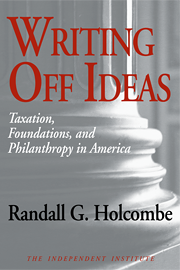George W. Bush’s and Barack Obama’s “stimulus” programs will permanently transform the American economy. The market-based system that has produced unprecedented prosperity relies on profit and loss, which rewards individuals and firms that add value to the economy and penalizes those that detract value. The various stimulus programs undermine that system.
My discussion will focus on four distinct components of the 2008–09 stimulus: Federal Reserve policy, the Troubled Asset Relief Program (TARP), the Obama stimulus spending package, and the bailouts of automobile and financial firms. Because there is a temptation to stereotype political parties, labeling the Democrats the party of big government and the Republicans the party of limited government and fiscal conservatism, it is worth emphasizing that these policies were bipartisan. The Federal Reserve policies came during the Bush administration and under Fed Chairman Ben Bernanke, a Bush appointee. TARP was implemented by Bush and his Treasury Secretary Henry Paulson, and the bailouts of automobile and financial firms were initiated in the Bush administration.
My message is one of hope and change. The change is the four stimulus programs. The hope is this: I hope I am wrong about the permanent negative effects these programs will have on America.
Federal Reserve Policy
Two fundamental elements of Federal Reserve policy changed in 2008: The Fed began making loans to nonbank financial institutions and buying financial assets other than securities issued by the U.S. Treasury.
The Fed was established in 1913 primarily to lend money to member banks based on their assets that could be used to pay off the loans. Until 2008 the only firms the Fed would lend to were member commercial banks. Then the Fed began making loans to nonbank financial institutions. It did so to provide those firms with liquidity, but in doing so it broke with precedent in two ways. First, it made loans to firms that were not members of the Federal Reserve System, and second, it made loans based on questionable assets, running the risk that the borrowers might not be able to repay the loans.
The second major change was that the Fed bought financial assets not issued by the Treasury–so-called toxic assets held by private banks and other firms. The true value of the assets was questionable, so the Fed risked losses. The Fed can afford to take those losses, however. The biggest problem with this change in policy is that by buying some assets rather than others, the Fed was supporting some firms over others.
For example, it bought assets from AIG, an insurance company, to keep it from failing and ultimately has taken over ownership of AIG with an 80 percent equity interest. The Fed also purchased assets of questionable value from investment bank Bear Sterns to facilitate its acquisition by JPMorgan Chase. Meanwhile, investment bank Lehman Brothers went into bankruptcy and failed. Why save Bear Sterns but not Lehman Brothers? The Fed also initiated the Term Asset-Backed Securities Loan Facility (TALF) to make loans to holders of various types of securities. TALF borrowers do not have to be banks.
These two new policies are problematic because they constitute an “industrial policy.” I am not questioning the effects of these policies. Hindsight will provide a better answer. Rather, I am questioning the precedent that the policies create for future Fed involvement in the economy.
The Fed has now established the precedent of making loans to firms that, at its discretion, it deems worth supporting, based on assets of questionable value. That puts the Fed in the position of picking winners and losers in the economy. Similarly, by choosing to buy “toxic assets” only from some sellers it is supporting some investors while letting others fend for themselves. Again, the Fed is picking winners and losers.
Its conduct is much like what the Japanese government has done for decades. In the 1980s that government, coupled with Japanese banks, directed assets to the firms they viewed as most important to the economy. This industrial policy was hailed by many observers as giving the Japanese economy a growth advantage. In the early 1990s the booming Japanese real-estate market collapsed, much as the U.S. market did in 2006–08, and many Japanese banks were left holding assets of questionable value, collateralized with mortgages with higher face values than the mortgaged property. Rather than allow insolvent banks to fail, the Japanese propped them up, maintaining their precarious positions, and the Japanese economy has stagnated ever since.
Japanese industrial policy is no longer held in such high regard, but the Federal Reserve’s recent actions have it engaging in the same type of industrial policy. Having set that precedent, the long-run effects are likely to be pernicious. Unless the Fed firmly repudiates its industrial policy, clearly saying it made a mistake that won’t be repeated, financial firms will take the same risks, believing the Fed will step in to help if the market turns against them.
Many think that to avoid a repeat of the 2008 melt‑down, the government should more tightly regulate the financial markets. President Obama has proposed a major overhaul of the regulatory apparatus.Yet financial firms are already among the most highly regulated firms in the nation, and it is implausible to think that the problems were the result of too little regulation. If anything, they were the effect of too much government involvement in those markets.
Market discipline is far superior to government regulation because firms that choose losing strategies will and should be allowed to fail. This would give every firm an incentive to choose profitable strategies and would weed out those that do not. The Fed’s industrial policy moves in the opposite direction, so more regulation would change nothing.
TARP
In September 2008 Bush Treasury Secretary Henry Paulson announced that the financial markets had frozen. Lending had ground to a halt, he said, and banks would not even lend to each other because their “toxic assets” called into question their solvency. Paulson asked Congress to pass emergency legislation providing him $700 billion to buy up those assets, creating liquidity in the financial sector so that normal lending activities could resume. TARP, approved on October 3, 2008, provided the money and gave the secretary the discretion to spend it as he saw fit.
Paulson claimed the money was needed immediately to prevent a collapse of the financial system. However, none of the TARP money went toward buying toxic assets. Instead the Treasury used the money to purchase equity interest in banks–that is, to partially nationalize many banks.
Paulson also pressured the nine largest banks to take the TARP money whether they needed it or not because if only some took the money, they would be stigmatized as weak, which could further undermine their financial positions. So now the federal government is the owner of a substantial share of the American banking industry.
Some of the strings attached to that money did not appear until after the government already bought into those banks. Obama and Treasury Secretary Timothy Geithner wanted to regulate the pay of bank executives, claiming that the federal government, as part-owner of those banks, should limit excessive pay. As a result, many recipients of TARP money are anxious to repay it and to buy back the stock the federal government now owns. But the federal government has put roadblocks in the way of banks that want to get out from under the burdens that come with TARP. The government likes that control. One fear that Geithner expressed is that if some banks escape the strings attached to TARP, they might raise executive pay, leading the better bank execs to leave the TARP—encumbered institutions for the higher pay at those banks that are free of TARP. (Some banks have started to pay the money back.)
The Obama Stimulus Package
Immediately after his election, Obama pushed hard to get Congress to pass a nearly $800 billion spending bill to stimulate the economy, which some claimed was mired in the worst recession since the Great Depression. While history will judge whether the recession was that severe, the rhetoric served to pass the bill. However, it is difficult to identify the features that make it a stimulus bill rather than just a big spending bill. In fact, the spending is largely for items Obama campaigned on. Much of it will occur after 2009 and so does not qualify as a stimulus for a depressed economy.
A lot of the alleged stimulus money was directed toward sectors that were holding up relatively well during the recession, such as healthcare and state and local governments. Government employment was steadier than private-sector employment when the bill was passed and can be expected to do even better with the money. Directing money toward relatively strong sectors is hardly the best way to stimulate the economy, even though it does further the goals that Obama campaigned on when he was running for president.
Even the economic analysis underlying the stimulus program can be called into question. The Keynesian idea is that by running budget deficits and increasing government spending, aggregate demand will be increased, pushing the economy toward prosperity. Of course, to spend that money, the government must first borrow it from elsewhere in the economy. There’s no free lunch. Moreover, if increasing government spending and running large budget deficits really led to prosperity, the economy would have been in nirvana by 2008. When Bush was elected in 2000 the federal budget was in surplus, and for Bush’s eight years government spending and the budget deficit continually increased, which by Keynesian logic should have produced a robust and maybe overheated economy, not an economy mired in recession. The Obama stimulus package was simply a continuation, on a much grander scale, of the eight years of Bush fiscal policy, a policy of continually increasing government spending and continually increasing budget deficits.
The Obama stimulus package was really just a big spending bill that did not offer much stimulus, but that will saddle the economy with bigger government from now on, hindering economic growth, slowing the recovery, and reducing prosperity
Bailouts
In addition to bailing out many failing banks and other financial firms, Bush and Obama also used taxpayer money to bail out Chrysler and General Motors. Bear in mind that when Obama campaigned for office and gasoline prices spiked above $4 a gallon, he advocated a windfall profits tax on oil companies. That idea fell by the wayside as prices fell in 2009, but these two policies provide a chilling example of how to undermine the very foundation of the market: When companies are successful and profitable–like oil companies in 2008–single them out for extra taxes, and when companies are unsuccessful and unprofitable–like auto companies in 2009–single them out for government subsidies.
One need understand only the most basic of economic principles to see how pernicious these policies are. If firms in an economy can take resources and combine them into products that are more valuable than the resources they started with, they are adding value to the economy and should be rewarded. In a market economy they are–through profits. If firms take resources and combine them into products that are less valuable than the resources they started with, they are harming the economy and they should be penalized. In a market economy they are–through losses. Profit and loss are essential to the operation of a market economy and provide the signals and incentives that have led to the remarkable economic progress that has characterized America (hampered as the economy is by government).
The bailouts began as loans to Chrysler and General Motors, which the firms had no chance of being able to pay back. The administration’s way of addressing this has been to negotiate to convert those loans into an equity interest in the firms, thus nationalizing the automobile companies in a manner similar to how TARP has nationalized banks. The federal government carries a big stick and is in a position to use that stick to its advantage. Under Obama’s bankruptcy plan for General Motors, the government will control 60.8 percent of the company, with 17.5 percent for a United Auto Workers trust fund. Bondholders could wind up with a 10 percent equity interest in the company.
On the surface this appears quite unfair to bond‑ holders, whose bonds had a face value of $27 billion. Some bondholders objected, rightly saying that the claims of holders of secured debt should come before the claims of the firm’s employees in any bankruptcy proceeding. But while some bondholders objected, many did not–because they were recipients of TARP money and therefore effectively under government control. TARP recipients JPMorgan Chase, Citigroup, Morgan Stanley, and Goldman Sachs owned about 70 percent of Chrysler’s debt. The government supported them with bailout money and then bullied them to give up their assets to the UAW.
The pernicious consequences go well beyond these transactions. How will this affect other union-heavy companies when they try to raise money in the bond market? The precedent is set for employees to move ahead of secured-debt holders in bankruptcy proceedings. Debt finance will become much more difficult for firms with unionized labor forces. One critic argued that the favoring of the UAW over bondholders amounted to shaking down lenders for the benefit of Obama’s political supporters, which is corruption and abuse of power. We would have done better to let the market and the bankruptcy court determine the fate of Chrysler and GM.
Fundamental Transformation
When we step back and look at the bipartisan efforts to rescue the economy from recession, those changes represent a fundamental transformation in the nature of the American economy. In the longer run Obama wants to substantially increase government’s role in health care, which is already largely in government’s hands with Medicare, Medicaid, SCHIP (health insurance for children), and the regulations that govern healthcare providers and pharmaceutical companies. Obama has also stated his intention to further regulate the energy industry to limit emissions and to shift production toward renewable energy sources. His cap-and-trade initiative would impose billions in costs on the economy and would effectively dictate the technologies by which energy is produced.
Few commentators are looking at the long-run implications of these changes, focusing instead on how much the proposed Obama deficits will increase the national debt or on how the Federal Reserve’s increases in the monetary base will impact inflation in coming years.
Déjà Vu All Over Again
I have described the changes. My hope is that I am overestimating their long-run impact. Indeed, the nation has found itself in similar situations before. In the 1970s we faced economic stagnation, rising unemployment, and rising inflation, which soared into the double digits. There were government-mandated price controls and frequent lines at the gas pumps as a result of shortages caused by those price controls. There was every reason to be pessimistic, but in the 1980s the Reagan administration turned many of those things around. Tax rates were slashed; the price controls were abandoned; and a more deregulated economy led to two decades of growth and prosperity. At least some of the credit for this, as well as much of what happened in Margaret Thatcher’s England, must be attributed to the power of ideas emanating from Milton Friedman and other free-market thinkers.
Similarly, in the 1940s socialism seemed such an attractive alternative to American capitalism that F. A. Hayek wrote The Road to Serfdom, arguing that social‑ism was that road, and Joseph Schumpeter, in Capital‑ism, Socialism, and Democracy, lamented that in democracies people could vote away their freedoms and that the people who benefited the most from a free economy were unwilling to defend it. Yet America prospered. When the Berlin Wall collapsed in 1989, followed by the demise of the Soviet Union in 1991, there was every indication that everyone would recognize that market allocation of resources is better for everyone than government planning.
Now we stand, two decades later, on the brink of the most significant erosion of the market economy since the New Deal, with relatively few dissenters. In a few short centuries markets have taken much of the world’s population from subsistence to remarkable prosperity and continuing economic progress. Are we really ready to abandon that system and replace it with something similar to what resulted in the collapse of the Soviet Union?
Reprinted with permission. © Copyright 2009, Foundation for Economic Education.













